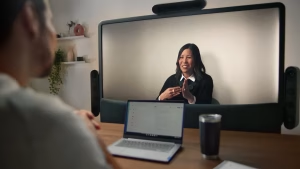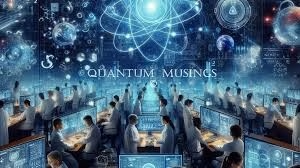Project Starline by Google: The Future of Holographic Video Calls

Google’s Project Starline brings lifelike holographic video calls to life using 3D imaging, light field displays, and AI. Discover how it will transform communication forever.
In an age where communication is instant but still lacks the human connection, Google is working on a solution that feels like science fiction brought to life. Meet Project Starline — a revolutionary holographic video calling system that offers realistic 3D conversations in real time.
This isn’t Zoom. It’s not FaceTime. It’s next-level immersive communication.
Let’s break down what it is, how it works, and why Project Starline may be the future of virtual communication across industries.
🔍 What is Project Starline?
Project Starline is a research project by Google aimed at making remote communication feel as lifelike as sitting across from someone in the same room. It does this using:
- High-resolution 3D cameras
- Infrared depth sensors
- Custom-built light field displays
- AI and machine learning algorithms
The result? A lifelike, 3D holographic version of the person you’re talking to — with real-time eye contact, facial expressions, and spatial presence.
It’s as if the other person is physically there.
📌 SEO Keywords: Project Starline, Google holographic video calls, 3D video conferencing, future of virtual meetings, Starline technology explained
🧠 How Does Project Starline Work?
1. Volumetric Video Capture
Starline uses multiple cameras and depth sensors to scan the person from multiple angles. It captures data in real time, creating a 3D model of the user’s face and upper body.
2. Light Field Display
Instead of showing the 3D image on a flat screen, Starline projects it on a light field display. This allows your eyes to perceive depth, texture, and motion parallax — key elements that make the image look real.
3. AI Compression and Rendering
Google uses machine learning algorithms to compress this massive amount of 3D data and transmit it over standard internet connections with low latency. The system ensures real-time rendering without lags or visual delay.
✅ The result is a holographic video call with no headset, no VR gear, and no screen-sharing barriers.
📡 Key Technologies Behind Starline
- Machine Vision: To capture the user’s shape, depth, and movement
- Computer Graphics: To reconstruct 3D models instantly
- Light Field Rendering: To project 3D visuals with depth and realism
- Spatial Audio: To deliver directional sound based on user positioning
- AI-based Compression: To reduce data load and latency during transmission
📌 SEO Tags Used: AI video conferencing, 3D holographic meetings, volumetric video, light field display, spatial communication technology
🎯 What Makes Starline Different from Traditional Video Calls?
| Feature | Traditional Video Calls | Project Starline |
|---|---|---|
| 2D or 3D | Flat 2D | Real 3D Holographic |
| Eye Contact | Rare or distorted | Realistic and natural |
| Spatial Presence | Not possible | Feels physically present |
| Hardware | Webcam & mic | 3D cameras, sensors, custom display |
| Interaction Quality | Basic | Deeply immersive |
💼 Use Cases of Project Starline
🏢 Business Meetings
Executives can connect with teams and clients around the world without losing the power of face-to-face interaction. The depth of communication improves trust, negotiation, and productivity.
🧑⚕️ Telemedicine
Doctors can speak with patients in a full 3D setting, assessing facial expressions, posture, and non-verbal cues. This level of realism is critical in mental health and diagnostics.
🎓 Remote Education
Educators can stand face-to-face with students virtually. Students feel present and engaged, improving learning outcomes.
💬 Personal Communication
Long-distance friends and families can feel emotionally closer, bridging the gap that traditional video calls often leave.
🌐 Starline’s Role in the Future of Remote Work
With the rise of remote and hybrid work models, companies are seeking better solutions than conventional video calls. Google believes human presence and connection matter, even when people are far apart.
Starline could become the next-gen communication tool in global offices, replacing flat screens with 3D portals that feel like real interactions.
🔐 Privacy and Security
All communications on Starline are expected to be end-to-end encrypted. Google’s infrastructure ensures that sensitive conversations remain confidential, private, and protected from interception.
Since holographic capture involves real-time 3D scanning, data protection will be a core feature, ensuring users are always in control of their visuals and audio.
📈 Current Status of Project Starline
Google revealed Project Starline at Google I/O 2021, showcasing real-time demos that impressed both engineers and the media. In 2023, Google began limited enterprise trials with healthcare providers and tech partners like Salesforce.
While it’s not yet available to the public, Google has hinted that Starline could be commercialized in the near future — likely starting in corporate and healthcare settings.
🔎 Keywords: Project Starline Google I/O, Starline demo, Starline commercial release, Starline enterprise trial
🤖 Starline vs Meta, Apple, and Microsoft
While Meta focuses on the metaverse using VR headsets, and Apple Vision Pro targets augmented reality, Starline keeps things simple: No headset. No goggles. Just sit down and talk.
Microsoft has Mesh for Teams, but it’s still avatar-based.
Google’s approach is unique — it uses real-life volumetric video and light fields, aiming for pure realism instead of virtual reality.
✅ Starline = Presence Without Immersion Devices
⚠️ Limitations and Challenges
While the promise of Project Starline is exciting, there are still barriers:
- High-cost hardware (currently not consumer-grade)
- Massive bandwidth and processing needs
- Physical space requirement for full 3D booth
- Limited scalability in current form
- Privacy concerns around constant 3D data capture
Google is actively working to make the system more compact and affordable for mainstream adoption.
🔮 Future of Project Starline
Google aims to miniaturize Starline hardware and make it widely accessible. Imagine a future where Starline booths are in:
- Airports
- Offices
- Hospitals
- Classrooms
- Homes
This would bring natural, human communication to every corner of the digital world — without VR goggles or avatars.
📌 The long-term goal: Erase the boundary between digital and physical conversation.
✅ Final Thoughts
Project Starline is more than a technological demo — it’s a bold step toward truly human digital communication. It merges cutting-edge AI, 3D capture, light field projection, and real-time rendering to deliver something no video call ever could: Presence. Connection. Emotion.
If successful, it won’t just change how we call each other. It could redefine remote collaboration, healthcare, education, and global communication.
The future isn’t just calling — it’s holographically arriving.





